When it comes to selecting an ideal astrology app tech stack, this is the phase that may get you confused, right?
In the astrology app, it's essential to create a complete app with effective and important technologies that support the features of your app.
We understand the importance of including the technology stack in the app, thus, here, you can find all the essential determinants and components to make your selection process simpler.
Are you ready to begin with the same?
In this blog, we’ll take a closer look at the key components, the selection process, and everything else you need to know about the astrology app tech stack, so you can make smarter, more informed decisions.
About Astrology App and Related Stats
When you enter the astrology app industry, learning about the basics is important.
To answer the question “how to create an astrology app tech stack?”
It's essential to continue learning about the astrology app and related stats first.
An Astrology app is all about the framework that is built on the superstitious belief that things like the motions, positions, and relations of the planets, the moon, and the sun are used to interpret or predict human characteristics and other related affairs.
The astrology app is a mobile app designed to provide users with astrological insights, predictions, and related services.
-
- In the year 2021, the global revenues of mobile astrological and horoscope apps amounted to approximately two billion U.S dollars. Additionally, the global meditation apps market is expected to surpass 19 billion U.S dollars by the year 2031.
- The global astrology app market size was USD 4.02 billion by the year 2024, which is projected to reach a USD 29.82 billion by the year 2033, at a CAGR of 24.93% during the forecasted period from the year 2025 to 2033.
- The global astrology market size was valued at $12.8 billion in the year 2021 and is projected to reach $22.8 billion by the year 2031 that is growing at a CAGR of 5.7% from the year 2022 to 2031.
Now, as you are aware of the concept and related market stats, let’s begin with the basics in the following section.
Basics of Astrology App Tech Stack
What are the core functions or basics you need to learn before identifying the technology stack for an astrology app?
Let’s learn more here.
1. Programming Languages
The programming languages that are used to write the application’s code are Python, Java, JavaScript, Ruby, and many others, depending on the specified platforms such as iOS and Android.
This can be learned or examined in the formal and structured ways for people to communicate instructions to a computer.
2. Frameworks
Frameworks in the tech stack can be referred to as the tools useful to provide a structured approach to development, simplifying the tasks and improving the code organization.
It is a collection of tools, languages, and technologies useful for building software applications. It comprises frameworks for the UI development, backend frameworks for the server-side logic, as well as database technologies for the data storage.
3. Servers
Servers are the infrastructure that typically comprises technologies such as web servers, databases, and application servers.
The servers prioritize reliability, security, and performance, whereas a regular computer focuses on the individual user's needs.
4. Operating Systems
Operating systems are the underlying software that manage hardware, along with software resources such as Linux or Windows.
Within the tech stack, the operating system helps provide a platform for running and interacting with the device’s hardware as well as software.
5. Frontend
The frontend of an app is the user-facing part or the client-side, which users interact with directly. It is the first impression among the users that helps the apps gain the attention of potential audiences.
It is the part of the application that comprises the key aspects, including user interaction, visual elements, user interface, and user experience.
These were the basics of the tech stack that you should cover before identifying the key components to be included in the Astrology app tech stack.
Well, it's time to learn more in the following section.
What Should be Included in the Astrology App Tech Stack?
Tech stack is an inseparable part of the process to create an astrology app
Puzzled about what to include in the astrology app tech stack?
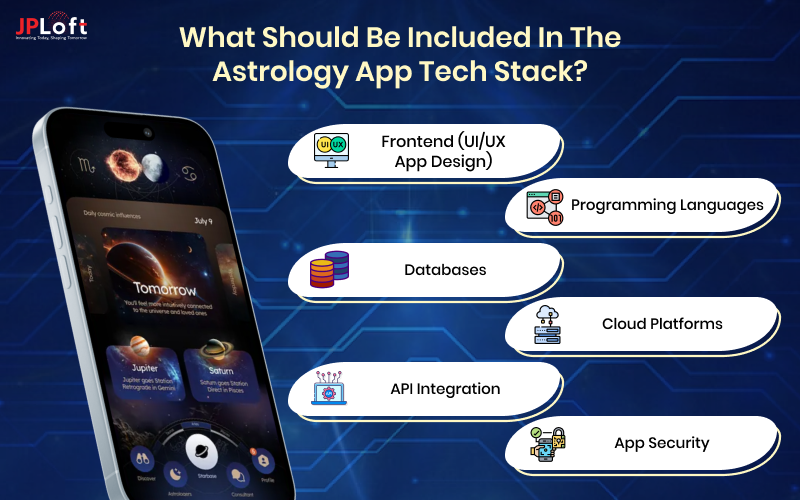
Well, here is the list you can follow.
1. Frontend (UI/UX App Design)
The frontend stack comprises the tools and technologies useful for developing the user interface. It's all about the ability to handle the visual elements, including charts and potentially localized content. The types of technologies you can include are:
-
- HTML: It is the first layer of any website that develops the code version of a wireframe over the webpage. It helps in
- CSS: This is responsible for the format and layout of the app. Additionally, it allows the app to create visually appealing and responsive designs, which makes websites more engaging and user-friendly.
- JavaScript: This frontend technology is developed to create site pages that work well across different programs, stages, and devices.
Tools
-
- Figma: The designers use this keyword to create all the app’s screens from the login to the horoscope displays. It is a popular tool for designers, product managers, writers, and developers.
- Sketch: Sketch is a powerful Mac-based tool that is focused on visual design, with a focus on vector-based graphics.
- Adobe XD: It is a versatile tool and network-effective for designing apps and for creating interactive prototypes and collaborating with stakeholders.
2. Programming Languages
The selection of the programming languages within the astrology app tech stack relies on the platform and approach you adopt for the same. Here’s a list you can proceed with.
-
- React Native (JavaScript): It is a cross-platform framework that helps you write the code once and then deploy it to both platforms, including iOS and Android.
- Swift (iOS) and Kotlin (Android): with these languages, you can build native apps that offer optimal performance and help to launch the app on the iPhone and Android platforms.
- JavaScript/TypeScript: Through using the frameworks, including React and Angular, JavaScript has spread its dominance. This can be used in the astrology app tech stack to support the backend of the features implemented there.
Tools
-
- IDES: it stands for the Internet Demonstration and Evaluation System. The system helps the developers with code completion, syntax highlighting, debugging, and integration with other tools.
- Code Editors: Code editors are lightweight text editors with features for syntax highlighting the code and different essential features.
- Version Control System: These systems can track and manage the changes to files or code over time, which allows developers to collaborate effectively.
3. Databases
A database is an organized collection of data that is stored and accessed electronically. It is an important tool used for collecting and organizing information. Additionally, it stores information tailored to specific use cases and requirements.
-
- PostgreSQL: It is an advanced and open-source relational database management system. Thus, this database network has relational capabilities and has an object-oriented design.
- MySQL: MySQL is an open-source relational database management system that uses the Structured Query Language to interact with and manage databases.
- Oracle Database: It is a relational database management system that is developed by the Oracle Corporation, and is used to store, organize, and then to manage data by organizing it into new tables with rows and columns.
Tools
-
- ER/Studio: It is a data architect leading industry tool used for designing and understanding databases. Helping companies discover documents and re-use the data assets. The tool connects data modeling with data governance to deliver a future-proof framework.
- DataGrip: This tool can be used as an important astrology app tech stack tool that supports a wide range of database systems including popular choices for an astrology app like MongoDB, PostgreSQL, and MySQL.
- Airtable: It is a tool that can be used in the astrology app as the database and allows the developers to create a relational database with tables for different types of data.
4. Cloud Platforms
The cloud services allow the astrology apps to store as well as manage the data without the requirement for expensive physical servers. Let’s learn more about how the cloud platforms can be used in the astrology app in the following points.
-
- Kubernetes: Kubernetes is a powerful cloud server that can be useful for automating container management and orchestration. It can help automate the scaling, deployment, and management of the containers across the cluster platforms.
- AWS Cloud Platform: AWS can provide scalable and reliable infrastructure for hosting the astrology app's backend, databases, and storage for user data and astrological information.
- Visualization: This tool allows the astrology apps to run on a single physical server, maximizing resource utilization and reducing infrastructure costs.
Tools
-
- Docker Swarm: It is an open-source container orchestration platform that is built and maintained by Docker.
- Platform-as-a-service tool: This is an important tool that offers a higher-level abstraction, which provides developers with an engaging platform to build and deploy crucial applications.
- Google Cloud Platform: It serves as a robust and scalable cloud server for the astrology app that can provide different infrastructures and platform services.
5. API Integration
When it comes to the astrology app, the API integration is one of the factors that comes foremost. API integration can act as a crucial technology for the cloud platforms that enable seamless communication over the astrology apps. This might increase the total cost to develop an astrology app, well, let’s learn more details.
-
- AstroSeek API: This API grants access to the natal charts, horoscopes, and a wealth of astrological knowledge. It can be further used to create a comprehensive astrology app for providing personalized horoscope insights.
- Swiss Ephemeris API: This API network is based on the planetary and lunar ephemeris that is used for performing astrological and astronomical calculations.
- General-purpose API integration tools: Libraries and SDKs are among the important general-purpose API Integration tools within various programming languages (Python, JavaScript, Java, etc)
Tools
-
- Pipedream: With this tool, users can connect APIs remarkably fast to automate any kind of procedure that connects the APIs well.
- Zapier: It is a web automation platform used to connect diverse apps and services for automating tasks without any kind of coding.
- Workato: It is an enterprise automation platform that allows businesses to design, secure, and manage APIs, enabling developers to integrate SaaS applications as well as legacy systems.
6. App Security
Well, if you want to avoid the challenges in the astrology app, securing the app with techniques is important. App security is helpful to secure the app through authentication and authorization. It does enforce the guidelines for password complexity, length, and more. Let’s learn the technology details below.
-
- Strong password policies: These are the strong password policies that enforce the guidelines for the password complexity, length, along with regular updates.
- JSON Web Tokens (JWT): Use JWT for securely transmitting authentication and authorization information between the client and server after successful login. Ensure proper signature verification and token management.
- MFA (Multifactor authentication): It is an important act of security measure used to prevent unauthorized users from accessing secure accounts.
Tools
-
- QAuth 2.0: It is a security tool, which is a popular and widely used authorization framework that permits users to grant third-party applications access to the data, without revealing the names and passwords.
- Firewall: It protects the networks and systems by blocking unauthorized access.
- Secrets Detection: You can use and implement the tools like Jit, that can help to identify and prevent the secrets from being exposed in the application code. iIt is helpful to boost the mobile app security.
Let’s learn more about the same within the table presented below.
|
Component |
Framework/Technology |
Description |
Use Case |
|
Frontend |
React Native / Flutter |
Cross-platform UI frameworks for mobile app development |
Create responsive, native-like UI for Android & iOS |
|
Backend |
Node.js / Django |
Server-side frameworks for handling logic and APIs |
Manage user data, daily horoscopes, and predictions |
|
Database |
MongoDB / PostgreSQL |
NoSQL/SQL databases for storing structured data |
Store user profiles, birth charts, and astrological data |
|
Astrology Engine |
Swiss Ephemeris / Maitreya |
Libraries for astronomical calculations and charts |
Generate accurate birth charts and planetary data |
|
API Integration |
REST / GraphQL |
Interfaces for connecting the frontend and backend |
Fetch horoscope data, zodiac signs, astrology reports |
|
Cloud Hosting |
AWS / Firebase |
Cloud platforms for hosting, authentication, and storage |
Scalable hosting, real-time data, push notifications |
|
Analytics |
Google Analytics / Mixpanel |
Tools to track user behavior and app usage |
Improve user engagement and feature optimization |
Are you ready to build a tech stack for your astrology app?
Well, you haven’t learned it all now; there can be important factors that might impact the overall astrology app tech stack decisions.
Let’s figure them all out in the section below.
Essential Factors Influencing Astrology App Tech Stack Decisions
Without identifying the factors influencing your decisions, you cannot begin with the crucial tech stack phase.
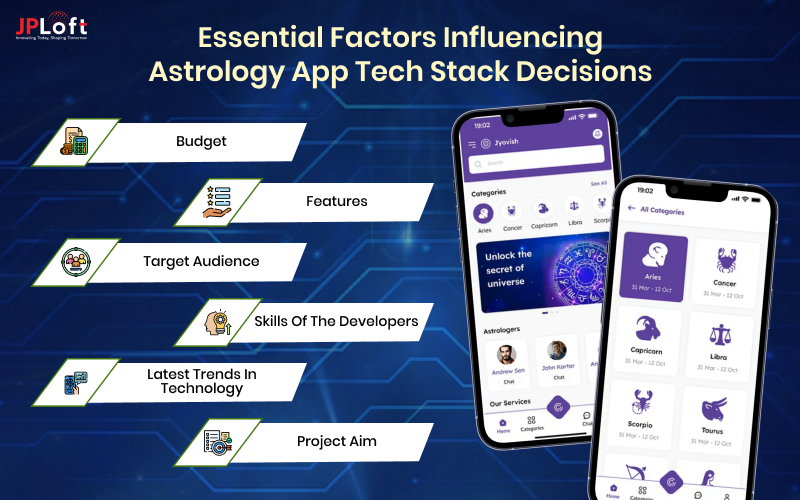
These factors will help you to consider all the related determinants that have a high influence over the app. Check them out below.
1] Budget
You cannot think of continuing with the tech stack of an astrology app without estimating the overall budget for the app.
A high budget will help you include the latest technologies in the astrology app. A complicated technology will result in an increase in the cost to create an Astrology App
2] Features
The integration and implementation of the complicated astrology app features will influence the selection of the technology stack for the astrology app.
It is a specific app that refers to the functions and capabilities that an app offers, including horoscopes and compatibility checks.
3] Target Audience and Platform Selection
Another crucial factor to note is the target audience and platform selection.
Here, the selection of the platforms, including iOS and Android, should be considered along with the target audience’s preferences.
4] Skills of the Developers
The skills of the developers have a high influence over the technology stack.
Here, as an entrepreneur, you should evaluate the competency of the developers and then make the decisions for the technology stack accordingly.
5] Latest Trends in Technology
In the current era of a competitive environment, the implementation of the latest technologies can enhance or diminish the complete app in the market.
Hence, it becomes vital to include the latest technologies based on the present astrology app trends.
6] Project Aim
Apart from this, it's essential to define the project's aim for the app when you begin with the technology stack.
If your project's aim is not clear, you cannot proceed with the development process, right? Well, it's the essentials that you cannot ignore.
These were the crucial factors that you cannot ignore when it comes to an astrology app.
Now, let’s proceed with the steps to build an ideal tech stack for an astrology app in the following section.
Process to Select an Ideal Tech Stack for an Astrology App
How do you think that the top astrology apps lead the market?
Well, the answer is hidden in the crucial process when it comes to start with the ideal tech stack.
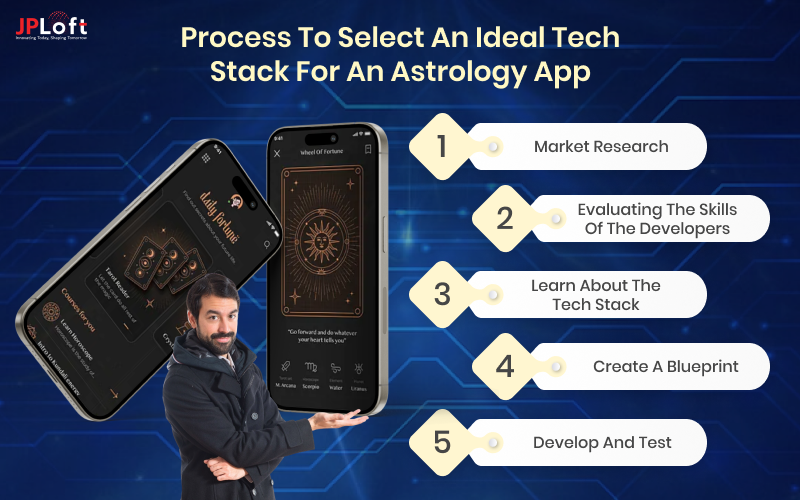
Here is the list you can check.
Step 1: Market Research and Need for the App
Here, you should examine two crucial factors, including the market analysis related to the app and its requirements.
Other than this, you should be able to evaluate the needs of the potential market audience, which is required to combine with the aim of the project.
Step 2: Evaluating the Skills of the Developers
When it comes to tech stack, it is crucial to know what the developers can perform best for you. Thus, you should be able to evaluate the competitive strategy for your customized app development. Under this step, you can discuss various determinants with the developers, such as their experience, work, etc.
Step 3: Learn About the Tech Stack
Any developer cannot help you with the technology stack if you aren’t aware of the basics. There remains a high probability of being fooled by them.
Thus, you should learn at least the basics, so that you might perform a discussion with the developers.
Step 4: Create a Blueprint
Now, it's time to clarify the blueprint of the technology stack. It's all about the detailed roadmap for how to proceed with the technology stack.
Astrology apps require features that are more customized and reliable, thus, the technology stack should support these factors.
Step 5: Develop and Test
Well, it's essential to develop the complete app and then test it with prompt tools and frameworks.
You should conduct testing under several parameters and landscapes. Testing needs to be authentic and able to identify further errors, which might impact functions.
You might consider implementing AI in astrology apps when it comes to selecting a suitable tech stack.
These were some of the crucial steps that you needed to proceed with when it comes to the astrology app tech stack.
How can JPLoft Help you Select a Suitable Astrology App Tech Stack?
Are you searching for a team of experts to build a tech stack for your astrology app tech stack?
No need to worry.
The experts at JPLoft are ready to help you with all the essential methods and techniques that will support the app and strengthen its capability to serve the users better.
We are the leading Astrology App Development Company, focused on delivering integrity and quality in the same aspect.
Our team will conduct a complete market analysis for your app and will help you with the technology to include in the app to enhance its functionality.
Along with this, our team can guide you with the respective tools and techniques to use and will implement them as per your requirements.
Conclusion
Here, you have learned about the essential components, from front-end frameworks like React Native and Flutter to back-end languages such as Python and Node.js, alongside crucial database choices like MongoDB and PostgreSQL.
Additionally, have evaluated Factors like the app's features (including Vedic astrology elements) and target audience. Scalability, security (paramount for sensitive birth data), and API integrations for astrological data significantly influence these decisions.
By understanding these strategic pillars and following a structured selection process, entrepreneurs can build a responsive, reliable, and engaging astrology platform tailored to their specific goals and the cultural context of their users.
FAQs
Programming languages like Python, Java, JavaScript, Ruby, Swift (for iOS), and Kotlin (for Android) can be used depending on the specific platforms and the desired functionalities of the astrology app.
Popular front-end technologies include HTML, CSS, and JavaScript for web-based interfaces, along with tools like Figma, Sketch, and Adobe XD for UI/UX design. For mobile apps, React Native and Flutter are highlighted.
The blog mentions PostgreSQL, MySQL, and Oracle Database as relational database management systems. Tools like ER/Studio, DataGrip, and Airtable can also be used for database design and management.
Cloud platforms like Kubernetes, AWS Cloud Platform, and Google Cloud Platform allow astrology apps to store and manage data without the need for expensive physical servers, offering scalability, reliability, and cost-effectiveness.
Tools like AstroSeek API and Swiss Ephemeris API can provide astrological data such as natal charts and horoscopes. General-purpose API integration tools like Pipedream, Zapier, and Workato can also be utilized for connecting different services.







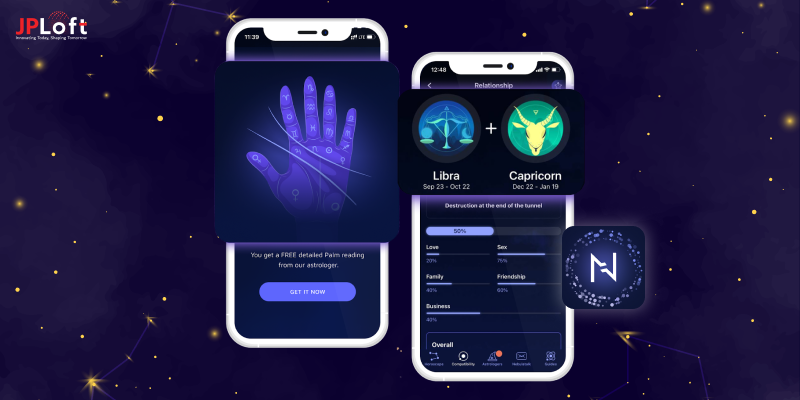
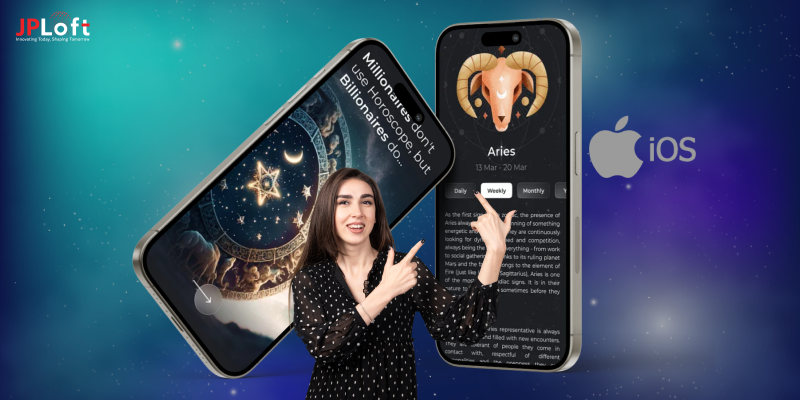
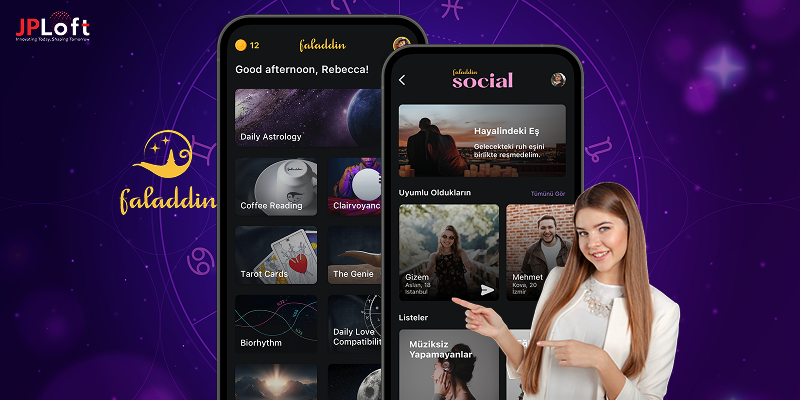


Share this blog